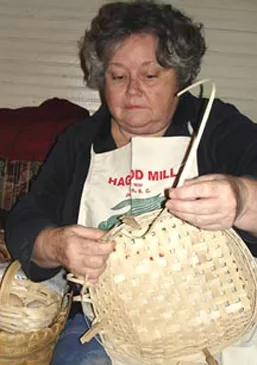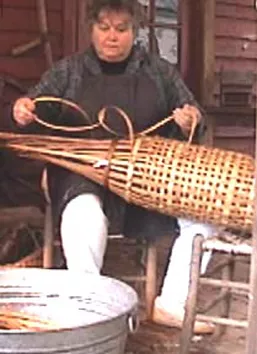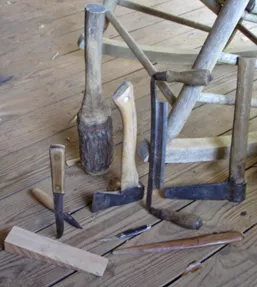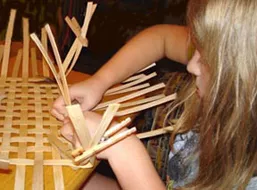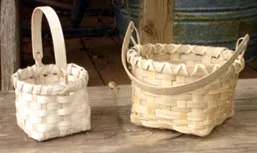Gale McKinley learned to make fish baskets by watching her father and grandfather. Her dad, Juby McKinley, is seventy-three years old, and he learned split-oak basket making from his dad, Amos McKinley. Gale proudly preserves this family tradition, passing it on to her oldest son, Brandon Downs.
Amos and Juby McKinley both made fish baskets (traps) for catching catfish in the Savannah River. Amos grew up on the river and knew a certain stretch of the river bottom so well that he could navigate it at night. Tom McKinley (Gale’s great-grandfather), with the help of his older sons, ran a ferry across the Savannah River, known locally as McKinley's Ferry. The elder McKinley ferried folks from Georgia to South Carolina and back. Tom McKinley was the one who really knew about the river and fishing, and how to do things, so Gale is fairly certain that he made baskets too.
To make a white oak basket, they first go into the woods, pick a tree they think will make a good basket, and then cut it to the length they want. They then bring it to the house, get under a shade tree and start splitting it with an ax, mallet, and wedges. They split the pole in half, then split each half in half. Then they split the fourths in half. They then have eight billets split cross grain.
Gale McKinley's baskets are made from white oak (Quercus alba). This species is strong, very heavy, tough, hard, close-grained and durable in contact with soil. Bands of several rows of large open ducts marking the layers of annual growth make the white oak easy to split. Younger trees, about eight inches in diameter, are chosen, providing a more pliable and easily split wood.
The European-American settlers first introduced split oak baskets in the sixteenth century. Since that time they have been an integral tool in the lives of farmers and continue to have a utilitarian, as well as aesthetic, role. Farmers used split oak baskets in various sizes for gathering, storing and transporting goods. It was not until the advent of mechanical farming after World War II that the extensive use of split oak baskets diminished in traditional farming. The seasonal round of farming activities dictated basket making. Most baskets were made during the summer months or after the fall harvest. Today, many baskets makers practice their art form after work, on the weekends, or after they have retired and can dedicate themselves to their craft full-time.
Progressively, the more traditional, utilitarian shapes of baskets have been replaced due to the demands of customers. Many baskets are named by shape, such as the round, square, bow or oblong baskets. Other baskets are named for their uses, like the egg, picnic, garden, sewing, newspaper, and market basket. Although there are many various shapes and sizes of split oak baskets available today, they all remain rooted in the traditional simple hamper and food basket. McKinley received the Jean Laney Harris Folk Heritage Award in 2004.
